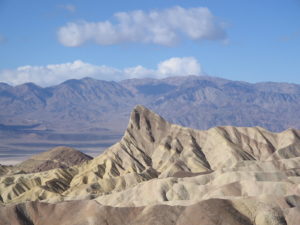 You start to notice the beauty even before you get there. As you head west from Las Vegas, you have to cross the Spring Mountains. The day my wife and I set out, it was clear and bright. But as we approached the mountains, we could see dark, brooding clouds overhead. We were concerned that rain would ruin the trip. But once we got over Spring Mountain summit, the sky cleared. We passed through the Red Rock Conservation Area and the Ash Meadows National Wildlife Refuge. We then came into one of the most uniquely named towns in America, Pahrump, Nevada. The vista on the horizon as you drive through Pahrump tells you nature is in charge here, and you should just try to take it all in. When State Line Road meets Route 190 at the Amargosa Opera House, you turn left to enter a place like no other, Death Valley.
You start to notice the beauty even before you get there. As you head west from Las Vegas, you have to cross the Spring Mountains. The day my wife and I set out, it was clear and bright. But as we approached the mountains, we could see dark, brooding clouds overhead. We were concerned that rain would ruin the trip. But once we got over Spring Mountain summit, the sky cleared. We passed through the Red Rock Conservation Area and the Ash Meadows National Wildlife Refuge. We then came into one of the most uniquely named towns in America, Pahrump, Nevada. The vista on the horizon as you drive through Pahrump tells you nature is in charge here, and you should just try to take it all in. When State Line Road meets Route 190 at the Amargosa Opera House, you turn left to enter a place like no other, Death Valley.
Death Valley National Park is the largest national park outside of Alaska. It’s both the hottest and driest national park. And they mean hottest. On July 10, 1913 it reached 134 degrees. The highest air temperature ever recorded on Earth. It also has the lowest point in the United States of 282 feet below sea level. The valley sits between the Amargosa and the Panamint Mountains. The Shoshone settled here a thousand years ago, and trust lands have been set aside so they can live in their ancestral homeland. The first thing you realize is how insignificant you feel being enveloped by the sky and the earth. At several points, my wife and I said it looks fake. It looked like a painting. You could spend days in the park. We only spent a few hours. We stopped at Zabriskie Point. We looked down on Echo Canyon and east to the Funera Mountains part of the Amargosa range. The colors of the tan, brown, and green earth contrasted against the blue sky. The high clouds cast shadows on the distant mountains as your eyes moved to the horizon.
We then drove south and stopped at Golden Canyon Trial. We parked and walked a short distance on a trail cut into the rocks that gave us a look inside the crust of the earth. We got back on the two lane black asphalt ribbon that cuts through the valley. I thought about what it must have taken for men and machines to build a pathway through this sacred place that allows us to see and hear nature. But what you hear is silence. The stillness in such a huge landscape is not like the quiet you hear anywhere else. It makes you very aware of the small place we occupy in the bigger world. We headed farther south past Devils Golf Course. I will never complain about a tough golf course again.
Our last stop was Badwater Basin. It’s a salt water flat that got its name from prospectors who found their mules wouldn’t drink the water. There is a small sign up on the rocks overlooking the basin that marks 282 feet. You can walk out on the bottom of the country and press yourself against the gusts of wind that can almost knock you over.
We headed back the way we came in after a couple of hours. It is almost impossible to describe a place like this. Even the many pictures I took can’t capture what you feel here. The name Death Valley was supposedly given by a woman in a Gold Rush wagon train after they finally managed to find their way out of the valley in 1849. But it’s a place where you feel very much alive, and can be amazed by the power and beauty of nature.
Our national parks are over one hundred years old. We even got a life time pass we can use when we visit other parks. There are parks all over the country to enjoy. They are places where you can get away from the daily routine, and maybe get some perspective on the world. There is peace and beauty in light, shadow, and earth.
I’m so glad to see you’re enjoying life. Keep writing.
Well stated Michael. Use our Golden Age pass all the time. Our National Parks are one of the great treasures of this beautiful country. People who have not yet visited have no idea what they are missing.